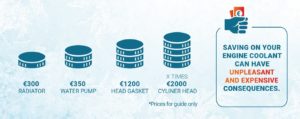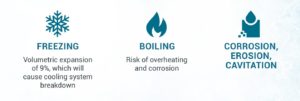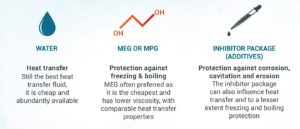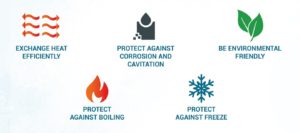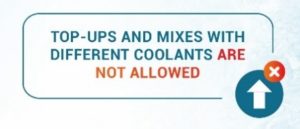Checking the coolant in a vehicle can often be easily forgotten, but just like the engine’s oil, the coolant is also vital to the performance of any vehicle and requires careful attention. Coolant prevents engines from both overheating and freezing, ensuring a smooth and efficient running engine. As well as hot weather, the energy produced by the engine can cause it to overheat, as only about a third of the energy produced is used to move the vehicle. The rest of this energy is converted to heat which, without coolant removing the heat not lost through the exhaust, would lead to overheating and costly breakages to engine components. Coolant also prevents the engine block from freezing and cracking during cold weather.
3 Main Reasons for Coolant /Antifreeze use:
- Cooling system failure can be the main reason for vehicle failure.
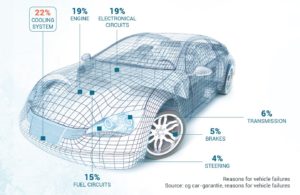
2. Coolant can avoid unnecessary expenses.
One of the main reasons for vehicle failure can be easily avoided by using the correct coolant and changing it at the correct intervals to ensure the lifetime of the cooling system. The estimated cost of a coolant replacement is about €80 – €100 (the cost of 5L of coolant and labour). As opposed to the potentially very expensive cost of replacing the cooling system components which could be required.
3. No Coolant or incorrect coolant could destroy an engine.
A coolant is necessary to:
- Protect all cooling system parts against:
- Guarantee that excessive heat from combustion is transferred:
Composition of Coolant/Antifreeze
Coolants/Antifreeze are composed of 3 parts: Water, MEG/MPG & an Inhibitor package.
Whilst the use of Water and MEG/MPG has remained constrained through the years, the types of inhibitor packages used have grown as the vehicles, and their cooling systems have advanced, requiring different performance levels. This inhibitor package is only a small part of the coolant, but it has a strong influence on the coolant quality. Only a few years ago, there were three main different types of inhibitor packages, whereas today, there 6 main packages used across the various coolants/antifreezes on the market with a wide variety of colours used to identify them, below is just a selection of the main colours used.
- IAT (Inorganic Additive Technology (mineral)) – Silicates – Green or Blue
- OAT (Organic Acid Technology) – Organic Acids – Orange, Red or Yellow
- HOAT (Hybrid OAT, Phosphate-free) – NAP-free – Turquoise
- HOAT (Hybrid OAT) – Silicates and organic acids – Yellow
- Si-OAT (Silicated HOAT) – Silicates and organic acids – Purple or Pink
- P-HOAT (Phosphated HOAT) – Phosphates and organic acids – Blue or Pink
Choosing the Right Coolant/Antifreeze
Freezing point alone does not determine a coolant quality. A good quality coolant should:
Colour should not be the only guide when comparing products, as you can see from the above list of the 6 main different types of coolants there is some cross over in the colours used. This list is just an example of the most common colours used, depending on the different manufacturers and markets various hues of all the colours of the rainbow can be used. Choosing the wrong coolant or mixing coolant types can have costly consequences as many coolants are incompatible with each other and will react in different harmful ways when mixed:
- Inhibitors equilibrium is strongly disturbed
- Protection against corrosion is no longer provided
- Risk of deposits in the system which reduce its effectiveness
In older cooling systems where a coolant with mineral inhibitor technology is required, adding a coolant with organic inhibitor technology could have expensive consequences as:
- Organic inhibitors have detergent properties which could scour the protective layer formed by mineral inhibitors.
- The metallic surfaces stripped bare can highlight micro cracks already there and leaks can appear.
For those unsure of the correct product type to use here are some points to keep in mind:
- Refer to the vehicles manual to see which type of coolant/antifreeze should be used to ensure you stay within the vehicles warranty.
- All to often people can be persuaded by price, especially cheaper universal products claiming to meet all vehicle requirements. This is no longer possible as specific manufacturers have specific requirements and formulations for their cooling systems. Hence the need for 6 different types on the market.
- Check the colour and look for similar colours but remember colour should only be used as a guide, and you need to check the exact type of coolant on the label to ensure it matches what your manual indicates is the correct type.
- If unsure, always consult a trusted stockist/supplier for the correct guidance on which type, you require and the best brand to look for.
Finol Oils offer a full range of all the different types of coolants and from our range of TotalEnergies Coolelf coolants or their own brand Cooltemp coolants, we will have a product for each of the different manufacturer requirements on the market and so will have the right product you need.

